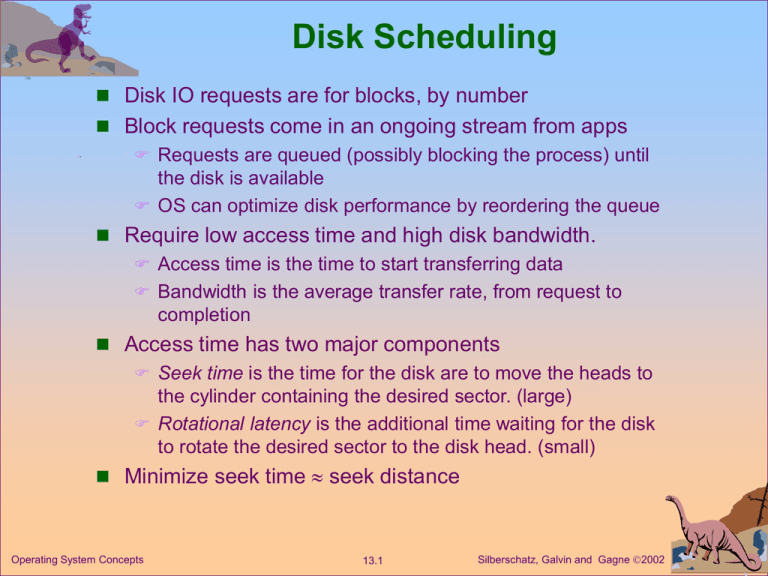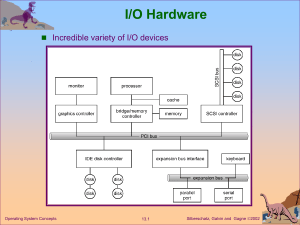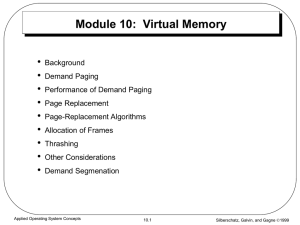Disks
advertisement

Disk Scheduling Disk IO requests are for blocks, by number Block requests come in an ongoing stream from apps Requests are queued (possibly blocking the process) until the disk is available OS can optimize disk performance by reordering the queue Require low access time and high disk bandwidth. Access time is the time to start transferring data Bandwidth is the average transfer rate, from request to completion Access time has two major components Seek time is the time for the disk are to move the heads to the cylinder containing the desired sector. (large) Rotational latency is the additional time waiting for the disk to rotate the desired sector to the disk head. (small) Minimize seek time seek distance Operating System Concepts 13.1 Silberschatz, Galvin and Gagne 2002 Disk Scheduling (Cont.) Given a request queue of block numbers, minimize summed seek distance Block numbers are translated into track and sector numbers Higher block numbers correspond to higher track numbers Sector numbers may not be known exactly, but can be computed for analysis Example, for a disk with range 0-199: 98, 183, 37, 122, 14, 124, 65, 67 Head pointer initially at 53 Optimal service order is 37, 14, 65, 67, 98, 122, 124, 183 (208) Operating System Concepts 13.2 Silberschatz, Galvin and Gagne 2002 FCFS Illustration shows total head movement of 640 cylinders. Operating System Concepts 13.3 Silberschatz, Galvin and Gagne 2002 SSTF Selects the request with the minimum seek time from the current head position. Illustration shows total head movement of 236 cylinders. SSTF scheduling is a form of SJF scheduling; may cause starvation of some requests. Not optimal Operating System Concepts 13.4 Silberschatz, Galvin and Gagne 2002 SCAN The disk arm starts at one end of the disk, and moves toward the other end, servicing requests until it gets to the other end of the disk, where the head movement is reversed and servicing continues. Sometimes called the elevator algorithm. Illustration shows total head movement of 236 cylinders. Waste at far ends Operating System Concepts 13.5 Silberschatz, Galvin and Gagne 2002 LOOK Version of SCAN Arm only goes as far as the last request in each direction, then reverses direction immediately, without first going all the way to the end of the disk. Operating System Concepts 13.6 Silberschatz, Galvin and Gagne 2002 C-SCAN The head moves from one end of the disk to the other. servicing requests as it goes. When it reaches the other end, however, it immediately returns to the beginning of the disk, without servicing any requests on the return trip. Treats the cylinders as a circular list that wraps around from the last cylinder to the first one. Illustration shows total head movement of 183 cylinders, plus return time. Provides a more uniform wait time than SCAN. Operating System Concepts 13.7 Silberschatz, Galvin and Gagne 2002 C-LOOK Version of C-SCAN Arm only goes as far as the last request in each direction, then reverses direction immediately, without first going all the way to the end of the disk. Illustration shows total head movement of 153 cylinders, plus return time. Operating System Concepts 13.8 Silberschatz, Galvin and Gagne 2002 Selecting a Disk-Scheduling Algorithm Performance depends on the number and types of requests. SSTF is common and has a natural appeal, but can starve requests SCAN and C-SCAN perform better for systems that place a heavy load on the disk - lots of requests to hit Optimal is NP-complete. Requests for disk service can be influenced by the file-allocation method and directory layout. The disk-scheduling algorithm should be written as a separate module of the operating system, allowing it to be replaced with a different algorithm if necessary. Either SSTF or LOOK is a reasonable choice for the default algorithm. Newer disks have Lower seek time relative to latency Built in scheduling - send requests in batches OS level scheduling is important at a coarser grain level, for important disk activity, e.g., VM Operating System Concepts 13.9 Silberschatz, Galvin and Gagne 2002 Bad Blocks Disks come from the factory with bad blocks File system solutions Keep a bad blocks list, etc Low level solutions Sector sparing replaces bad blocks with spares, by a mapping in the disk controller Sector slipping slides them down Interferes with disk scheduling - that’s why disks might be left to their own devices (ha ha) Operating System Concepts 13.10 Silberschatz, Galvin and Gagne 2002 Swap-Space Management Swap-space — Virtual memory uses disk space as an extension of main memory. Swap-space can be Carved out of the normal file system In a separate disk partition with a special file system (no directory, etc) Combination of these, e.g., Solaris, which always rereads text pages from the file system (they’re never dirty, and hence never swapped out) Swap-space management 4.3BSD allocates swap space when process starts; holds text segment and data segment. Solaris 2 allocates swap space only when a page is forced out of physical memory, not when the virtual memory page is first created. Operating System Concepts 13.11 Silberschatz, Galvin and Gagne 2002 RAID RAID schemes improve performance and improve the reliability of the storage system by storing redundant data. Disk striping uses a group of disks as one storage unit Bit striping gives parallel transfer for all size transfer Block striping gives parallel transfer for large transfers, and concurrency for small accesses Mirroring or shadowing keeps duplicate of each disk. Block interleaved parity combines the ideas RAID is arranged into six different levels. Operating System Concepts 13.12 Silberschatz, Galvin and Gagne 2002 RAID Levels Operating System Concepts 13.13 Silberschatz, Galvin and Gagne 2002 RAID (0 + 1) and (1 + 0) Operating System Concepts 13.14 Silberschatz, Galvin and Gagne 2002











